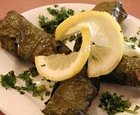|
Greek Appetizer Stuffed Grape Leaves It's easier to buy these, but they're never so good as when you make them yourself. Serve them with a cool, refreshing dollop of yogurt.
Leaves: carefully unwrap and dunk leaves, briefly, into a quart of boiling water, a couple at a time, to scald and soften. This makes them easier to work with. (If using fresh leaves, blanch them until soft, up to 1- 2 minutes.) Rinse under cold water and lay on paper towels to dry. Don’t worry about torn leaves: use them to patch holes in the other leaves. Filling: in a skillet, brown pine nuts till golden (about 2 minutes). Remove them, add oil to pan and saute onions and rice together, till onions are translucent. Return pine nuts to pan, add 1 C hot water, herbs, seasonings and sugar. Cover and cook over a low fire for 10 minutes. Cool. Assembly: preheat oven to 350. Place a grape leaf, shiny side down, on counter. Spoon 1- 2 tsp. of rice mixture onto stem end, fold sides inward, and begin to roll up, making it about 2 1/2" long, and about 3/4" to 1" thick. Don’t roll too tightly, as the rice will expand during final cooking. Squeeze a little to close up top. Make 12 roll-ups. Cook: layer the bottom of a wide, ovenproof skillet with 4 flat leaves and place roll-ups, 1/2" apart, on top of leaves. (This will prevent them from sticking to pan.) Cover roll-ups with 1 C hot water, add lemon juice and butter. Weigh stuffed leaves down by placing an ovenproof plate on top. Cover skillet with lid and place in oven for 30-40 minutes.* Serve: Cool stuffed leaves; serve chilled with yogurt and lemon wedges. (If you make roll-ups ahead of time, pour a little olive oil and lemon juice over them and keep covered with plastic wrap.) * Some people like the rice stuffing to be a slightly underdone, for a chewy, crispy texture. They'll cook leaves for 30 min. Others prefer well-cooked, tender rice, so will cook leaves for 40 min. Experiment for cooking times to get the texture you like. |
Tips & Glossary You may not have a number of ingredients used in Greek cooking in your spice shelf, but you can find them at Mid-Eastern food stores. So to avoid frustration, make a list of the items you need before trying out the recipes. Filo: aka phyllo, paper-thin sheets of raw, unleavened flour dough. Purchase frozen in most grocery stores and follow directions on package for thawing. When working with a sheet, keep others covered with a damp towel to prevent drying out. Grape Leaves: Grape leaves are sold canned in salted oil. Rinse off the salt before using. If you want, prepare your own: find fresh, tender young leaves and plunge them for 1 minute into boiling water (with 1 or 2 T lemon juice). Then proceed with recipe. After blanching, you can freeze them for later use. Here’s how: blanch as above, dunk in iced water, pat dry with towels, and seal in an air-tight plastic bag. They're safe for 6 months, but use quickly when thawed. Nutmeg: Use small whole nuts and store them, tightly covered, in a dry dark area. Grate what you need using the smallest grating edge or grind in a food processor. What a difference from store bought nutmeg! Pine Nuts: edible seeds of pine trees used in many Greek dishes. Before cooking, release flavor by lightly browning in a heated skillet Skewers: Use metal or wooden skewers for kebobs. If wooden, soak 30 minutes before using to prevent them from catching on fire. Rosewater: distilled from rose petals and used to flavor Mid-Eastern and Asian cooking. You can make your own. But, seriously, why would you? Purchase it at Asian or Mid-Eastern stores. Semolina: aka farina or Cream of Wheat; a coarsely ground wheat grain. You also know it as couscous. If made from durum wheat, it is used to make pasta. Tarama: poor-man's caviar. From carp roe, it is pinkish-orange and is what (along with food dye) gives taramasalata its lovely color. Buy it jarred in Mid-Eastern food stores.
|
Site by BOOM
![]()
LitLovers © 2024

